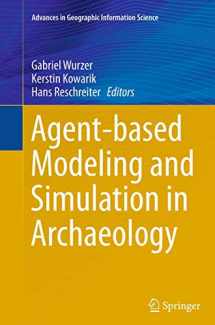
Agent-based Modeling and Simulation in Archaeology (Advances in Geographic Information Science)
ISBN-13:
9783319342825
ISBN-10:
3319342827
Edition:
Softcover reprint of the original 1st ed. 2015
Author:
Gabriel Wurzer, Kerstin Kowarik, Hans Reschreiter
Publication date:
2016
Publisher:
Springer
Format:
Paperback
283 pages
FREE US shipping
Book details
ISBN-13:
9783319342825
ISBN-10:
3319342827
Edition:
Softcover reprint of the original 1st ed. 2015
Author:
Gabriel Wurzer, Kerstin Kowarik, Hans Reschreiter
Publication date:
2016
Publisher:
Springer
Format:
Paperback
283 pages
Summary
Agent-based Modeling and Simulation in Archaeology (Advances in Geographic Information Science) (ISBN-13: 9783319342825 and ISBN-10: 3319342827), written by authors
Gabriel Wurzer, Kerstin Kowarik, Hans Reschreiter, was published by Springer in 2016.
With an overall rating of 3.6 stars, it's a notable title among other
books. You can easily purchase or rent Agent-based Modeling and Simulation in Archaeology (Advances in Geographic Information Science) (Paperback) from BooksRun,
along with many other new and used
books
and textbooks.
And, if you're looking to sell your copy, our current buyback offer is $0.3.
Description
Archaeology has been historically reluctant to embrace the subject of agent-based simulation, since it was seen as being used to "re-enact" and "visualize" possible scenarios for a wider (generally non-scientific) audience, based on scarce and fuzzy data. Furthermore, modeling "in exact terms" and programming as a means for producing agent-based simulations were simply beyond the field of the social sciences. This situation has changed quite drastically with the advent of the internet age: Data, it seems, is now ubiquitous. Researchers have switched from simply collecting data to filtering, selecting and deriving insights in a cybernetic manner. Agent-based simulation is one of the tools used to glean information from highly complex excavation sites according to formalized models, capturing essential properties in a highly abstract and yet spatial manner. As such, the goal of this book is to present an overview of techniques used and work conducted in that field, drawing on the experience of practitioners.


We would LOVE it if you could help us and other readers by reviewing the book
Book review

Congratulations! We have received your book review.
{user}
{createdAt}
by {truncated_author}


